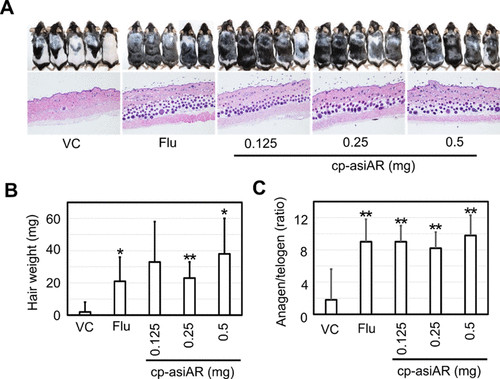- You are here: Home
- Disease Models
- Skin Disease Models
- Hair Growth Models
- Androgenetic Alopecia (AGA) Models
- Dihydrotestosterone (DHT)-Induced Androgenetic Alopecia (AGA) Model
Disease Models
- Oncology Models
-
Inflammation & Autoimmune Disease Models
- Rheumatoid Arthritis Models
- Glomerulonephritis Models
- Multiple Sclerosis (MS) Models
- Ocular Inflammation Models
- Sjögren's Syndrome Model
- LPS-induced Acute Lung Injury Model
- Peritonitis Models
- Passive Cutaneous Anaphylaxis Model
- Delayed-Type Hypersensitivity (DTH) Models
- Inflammatory Bowel Disease Models
- Systemic Lupus Erythematosus Animal Models
- Asthma Model
- Sepsis Model
- Psoriasis Model
- Atopic Dermatitis (AD) Model
- Scleroderma Model
- Gouty Arthritis Model
- Carrageenan-Induced Air Pouch Synovitis Model
- Carrageenan-Induced Paw Edema Model
- Experimental Autoimmune Myasthenia Gravis (EAMG) Model
-
Cardiovascular Disease Models
- Surgical Models
- Animal Models of Hypertension
- Venous Thrombosis Model
- Atherosclerosis model
- Cardiac Arrhythmia Model
- Hyperlipoidemia Model
- Doxorubicin-induced Heart Failure Model
- Isoproterenol-induced Heart Failure Model
- Arterial Thrombosis Model
- Pulmonary Arterial Hypertension (PAH) Models
- Heart Failure with Preserved Ejection Fraction (HFpEF) Model
-
Neurological Disease Models
- Alzheimer's Disease Modeling and Assays
- Seizure Models
- Parkinson's Disease Models
- Ischemic Stroke Models
- Acute Spinal Cord Injury (ASCI) Model
- Traumatic Brain Injury (TBI) Model
- Hypoxic-Ischemic Encephalopathy (HIE) Model
- Tourette Syndrome (TS) Model
- Amyotrophic Lateral Sclerosis (ALS) Model
- Huntington's Disease (HD) Model
- Intracerebral hemorrhage (ICH) Models
- Pain Models
- Metabolic Disease Models
- Liver Disease Models
- Rare Disease Models
- Respiratory Disease Models
- Digestive Disease Models
-
Urology Disease Models
- Cisplatin-induced Nephrotoxicity Model
- Unilateral Ureteral Obstruction Model
- 5/6 Nephrectomy Model
- Renal Ischemia-Reperfusion Injury (RIRI) Model
- Diabetic Nephropathy (DN) Models
- Passive Heymann Nephritis (PHN) Model
- Adenine-Induced Chronic Kidney Disease (CKD) Model
- Kidney Stone Model
- Doxorubicin-Induced Nephropathy Model
- Orthopedic Disease Models
- Ocular Disease Models
- Skin Disease Models
- Infectious Disease Models
Dihydrotestosterone (DHT)-Induced Androgenetic Alopecia (AGA) Model
Creative Bioarray has successfully developed a robust Androgenetic Alopecia (AGA) model, induced by dihydrotestosterone (DHT). This cutting-edge model is specifically designed to closely replicate the human condition of AGA, a common issue affecting millions globally. By utilizing DHT, a key hormone involved in the development of AGA, Creative Bioarray's model provides a reliable platform for studying the mechanisms of hair loss and for testing potential treatments. This model is a significant advancement in the field of dermatological research, offering researchers a valuable tool to explore the complexities of AGA and to develop effective therapies.
AGA is a common form of patterned hair loss in both men and women, influenced by genetics and androgen sensitivity, particularly the androgen. Testosterone is converted by type 2, 5-alpha reductase (SRD5A2) into DHT, leading to AGA. Excessive DHT shrinks hair follicles, replacing terminal hairs, with vellus hairs. While AGA affects quality of life, treatment options are limited to finasteride and minoxidil, which are not always effective and may have side effects. Therefore, animal models of AGA are critical for research to develop more effective treatments, as they allow the study of the disease's progression and the testing of new therapeutic agents.
Our Dihydrotestosterone (DHT)-Induced Androgenetic Alopecia (AGA) Model
Available Animal
Mouse
Modeling Method
Animals are subcutaneously injected with DHT for four weeks after hair removal.
Endpoints
- Body weight
- Hair growth evaluation (photo of mice)
- Histology analysis
- Biomarker analysis
- qPCR or Western blot
- Customized endpoints tailored to your specific research requirements
Example Data
 Fig. 1 In vivo validation of cp-asiAR therapeutic efficacy in an AGA mouse model. (A) Mice were injected with DHT daily to induce AGA-like hair loss and treated with either flutamide or various doses of cp-asiAR. Hair regrowth was assessed on day 21, showing significant promotion due to cp-asiAR. The dorsal skin was also processed for H&E staining. (B) Regrown hair was shaved and weighed, with cp-asiAR demonstrating marked hair regrowth compared to the control. (C) The proportion of anagen to telogen hair follicles was determined from the H&E sections, with results presented as mean and standard deviation. (Moon et al. 2022)
Fig. 1 In vivo validation of cp-asiAR therapeutic efficacy in an AGA mouse model. (A) Mice were injected with DHT daily to induce AGA-like hair loss and treated with either flutamide or various doses of cp-asiAR. Hair regrowth was assessed on day 21, showing significant promotion due to cp-asiAR. The dorsal skin was also processed for H&E staining. (B) Regrown hair was shaved and weighed, with cp-asiAR demonstrating marked hair regrowth compared to the control. (C) The proportion of anagen to telogen hair follicles was determined from the H&E sections, with results presented as mean and standard deviation. (Moon et al. 2022)
Quotation and Ordering
With a wealth of experience in creating animal models for hair growth studies, Creative Bioarray is committed to delivering high-quality, budget-friendly services. We aim to assist your research with dependable and cutting-edge solutions. Should you be interested in our services, we welcome you to reach out to us anytime or send an inquiry directly. Our advanced resources and specialized knowledge are here to propel your research forward.
Reference
- Moon, I.J., et al. Efficacy of Asymmetric siRNA Targeting Androgen Receptors for the Treatment of Androgenetic Alopecia. Molecular Pharmaceutics, 2022, 20(1): 128-135.
For research use only. Not for any other purpose.

